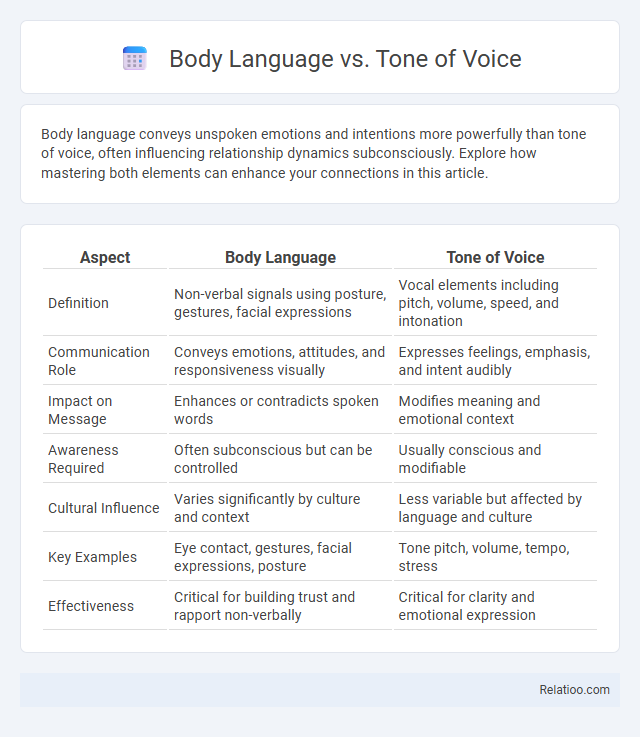Body language conveys unspoken emotions and intentions more powerfully than tone of voice, often influencing relationship dynamics subconsciously. Explore how mastering both elements can enhance your connections in this article.
Table of Comparison
| Aspect | Body Language | Tone of Voice |
|---|---|---|
| Definition | Non-verbal signals using posture, gestures, facial expressions | Vocal elements including pitch, volume, speed, and intonation |
| Communication Role | Conveys emotions, attitudes, and responsiveness visually | Expresses feelings, emphasis, and intent audibly |
| Impact on Message | Enhances or contradicts spoken words | Modifies meaning and emotional context |
| Awareness Required | Often subconscious but can be controlled | Usually conscious and modifiable |
| Cultural Influence | Varies significantly by culture and context | Less variable but affected by language and culture |
| Key Examples | Eye contact, gestures, facial expressions, posture | Tone pitch, volume, tempo, stress |
| Effectiveness | Critical for building trust and rapport non-verbally | Critical for clarity and emotional expression |
Understanding Body Language and Tone of Voice
Understanding body language and tone of voice is crucial for effective communication, as they often convey emotions and intentions more accurately than words alone. Your awareness of subtle gestures, facial expressions, and vocal inflections can enhance interpersonal interactions and reduce misunderstandings. Mastering these nonverbal cues empowers you to connect more deeply and respond appropriately in diverse social and professional settings.
The Science Behind Nonverbal Communication
Nonverbal communication encompasses body language, tone of voice, and facial expressions, each triggering distinct neurological responses that influence perception and social interactions. Studies reveal that up to 93% of communication effectiveness is determined by nonverbal cues, with body language conveying emotions through gestures and posture while tone of voice provides context via pitch, volume, and intensity. Neuroscientific research highlights the amygdala's role in processing these signals rapidly, enabling humans to assess intentions and emotional states beyond spoken words.
Key Differences: Body Language vs Tone of Voice
Body language communicates your emotions and intentions through facial expressions, gestures, and posture, often revealing subconscious feelings. Tone of voice conveys attitude and emphasis by altering pitch, volume, and speed, affecting how your message is perceived. Understanding the key differences helps you interpret non-verbal cues and vocal signals to improve communication accuracy.
Importance of Body Language in Communication
Body language conveys over 55% of the meaning in face-to-face communication, making it more impactful than tone of voice and spoken words combined. Your posture, gestures, and facial expressions provide critical nonverbal cues that shape how your message is interpreted and build trust with your audience. Mastering body language enhances clarity, emotional connection, and overall effectiveness in personal and professional interactions.
The Role of Tone of Voice in Conveying Emotions
Tone of voice plays a crucial role in conveying emotions by modulating pitch, volume, and pace to express feelings such as anger, happiness, or sadness, often more powerfully than body language alone. While body language provides visual cues through gestures and facial expressions, tone of voice delivers nuanced emotional context that shapes interpretation and enhances communication effectiveness. Research in communication studies highlights that vocal tone accounts for approximately 38% of emotional expression, underscoring its significance in interpersonal interactions.
Cultural Variations in Nonverbal Cues
Cultural variations significantly influence the interpretation of body language, tone of voice, and facial expressions, impacting communication effectiveness across different societies. Misunderstanding these nonverbal cues can lead to misinterpretations and barriers in your personal and professional interactions. Mastering cultural differences in nonverbal communication enhances your ability to connect and communicate appropriately in diverse environments.
Misinterpretations and Common Pitfalls
Misinterpretations often arise when body language contradicts tone of voice, causing confusion about the speaker's true intent. Common pitfalls include over-reliance on facial expressions without considering vocal cues, leading to false assumptions about emotions or attitudes. Accurate communication requires aligning tone of voice with consistent body language to prevent misunderstandings and enhance message clarity.
Enhancing Communication Skills: Practical Tips
Mastering communication skills involves understanding the interplay between body language and tone of voice. Your body language conveys confidence and openness through gestures, posture, and facial expressions, while your tone of voice adds emotional context and clarity to your message. Practicing consistent eye contact, modulating your vocal pitch, and aligning your physical cues with your words will significantly enhance how effectively you connect and communicate with others.
Body Language and Tone of Voice in Professional Settings
Body language and tone of voice are crucial components of effective communication in professional settings, often conveying more than spoken words. Confident posture, eye contact, and controlled facial expressions project authority and credibility, while a calm, steady tone of voice enhances clarity and fosters trust. Misalignment between body language and tone can lead to misunderstandings, making consistency essential for successful interpersonal interactions in the workplace.
Integrating Body Language and Tone for Effective Communication
Integrating body language and tone of voice enhances your communication by aligning nonverbal cues with vocal expressions to convey clarity and emotional depth. Effective use of gestures, facial expressions, and posture combined with modulation in pitch, volume, and pace ensures your message resonates authentically with the audience. Mastering this synergy boosts understanding and fosters stronger interpersonal connections.

Infographic: Body language vs Tone of voice
 relatioo.com
relatioo.com